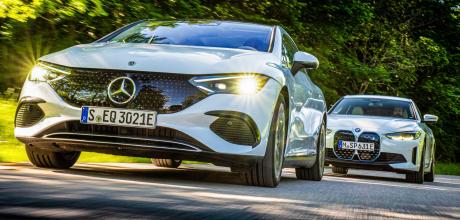2023 Mercedes-Benz EQE 350+ V295 vs. 2023 BMW i4 40 eDrive G26
The world might be goingelectric but you still fancy a nice German saloon. The choice remains the same: Mercedes or BMW?
Words Georg Kacher
Photography Tom Salt
THE MORE THINGSCHANGE
Giant test
THE DEFINITIVE VERDICT
You don’t know what you’ve got ’til it’s gone. Not literally gone in the case of the combustion-engined Mercedes-Benz E-Class W213 and BMW 3/4-series, but clearly beating a hasty retreat from decades of loyal service. Decades in which we’ve got very excited about the flagship AMG and M versions, but also come to trust the lesser models, and to take for granted their all-round excellence.
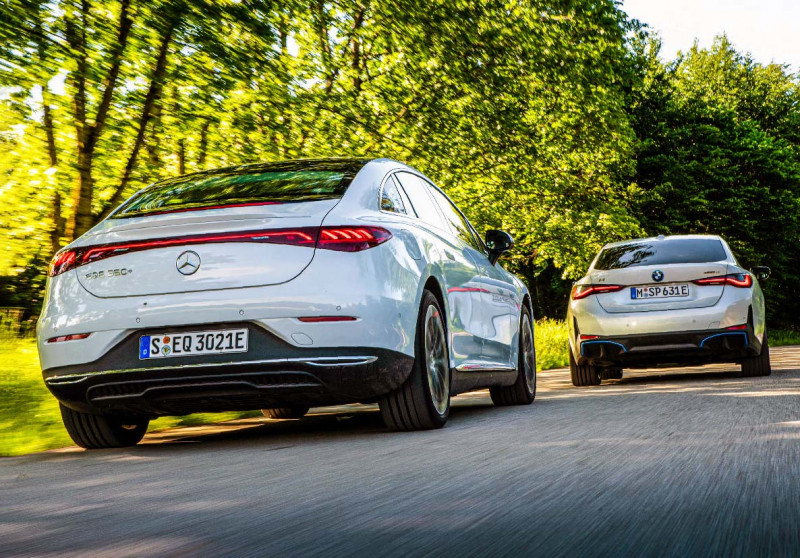
By hanging on to elements of the styling and the naming, both manufacturers are clearly hoping to carry over some of that goodwill to their electric equivalents. In the case of the BMW, it’s not all smoke and mirrors. The i4 is based on the same CLAR architecture as the 4-series, and both inside and outside it looks a lot like a petrol 4-series.
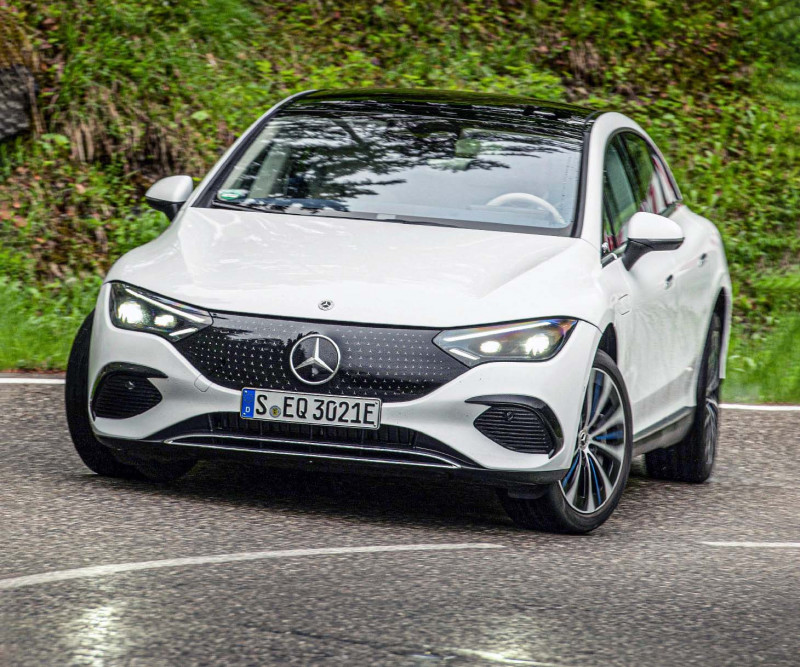
The EQE takes far more liberties with continuity. From some angles – especially side-on, where the truncated nose is most obvious – it’s clearly something quite different from the classic three-box ‘Stuttgart taxi’. Inside there’s a similarly large disconnect; yes, familiar Mercedes seats and vents, but the view out is disconcerting and the rear passengers are lost in space – space that’s only possible because this is part of the same EVA2 electric-only family as the EQS.
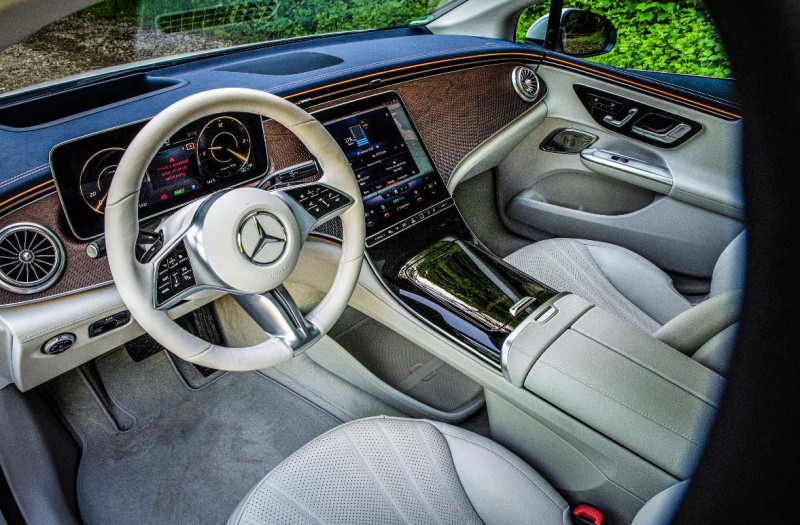
You’ll be aware that the 4-series and E-Class are one size different. The bigger dimensions of the Mercedes are amplified in the transition to electric, with the EQE much bigger than the i4 outside and roomier still on the inside.
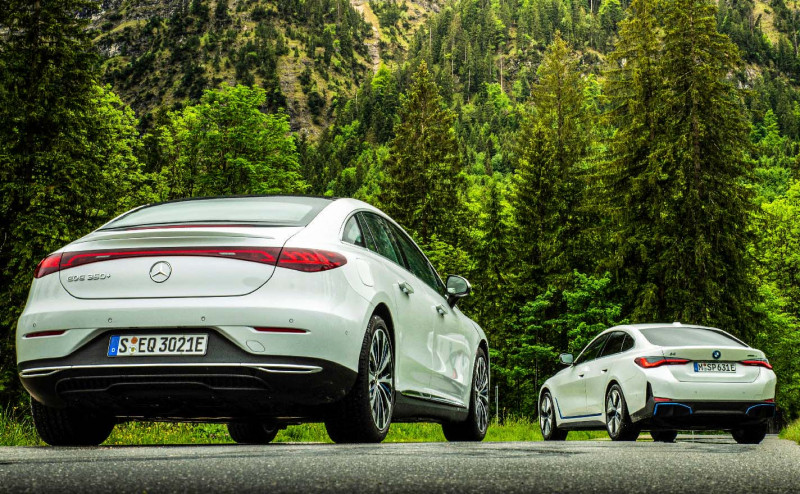
That’s reflected in the pricing. This is the entry-level i4, with a UK price of £55,345 on the road. The step up from Sport to M Sport spec, taking the price to £64,255, gets you mostly visual changes; it makes an eDrive 40 look a lot like the more powerful xDrive M50 (which itself costs £72,995).
The EQE, by contrast, starts at £76,450 on the road. That’s for an EQE 350+ (the only powertrain currently available, although others aren’t far behind) in base AMG Line spec. Adding £5k gets you AMG Line Premium; a further £7k reaches AMG Line Premium Plus, or the Exclusive Luxury level that is close to our German-market test car.
So a significant gap in price, and an unmissable difference of physical size. But the fact is that if you want a premium German electric saloon, and don’t want one of the flashy flagships, this is where you’d be looking. There’s currently no BMW electric rival to the E-Class, and no Mercedes electric alternative to the 4-series. So here we are: EQE versus i4.
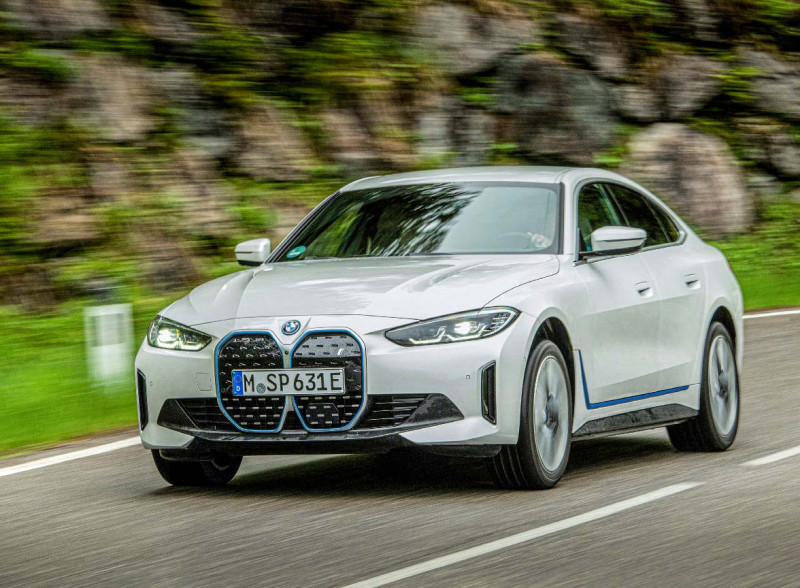
Where, exactly? In the Bavarian Alps, territory that the E-Class and 4-series would both relish. Let’s find out what the EQE and i4 make of it.
The BMW, with 335bhp and 317lb ft, is instantly more agile than the beefier and heavier (2355kg plays 2125kg) Benz, with its 288bhp and 417lb ft. Bear in mind, though, that the output numbers indicate the maximum power and torque, with the full boost effect active and the batteries over 60 per cent charged. When the energy cells are close to running on empty, and as soon as the power pack is beginning to feel the heat at about 105ºC, the car from Munich intermittently musters a mere 80bhp, which is barely enough to maintain the advertised top speed of 119mph. The 130mph Mercedes goes through a similar rollercoaster cycle which can – like in the i4 – be followed on the active drive monitor.
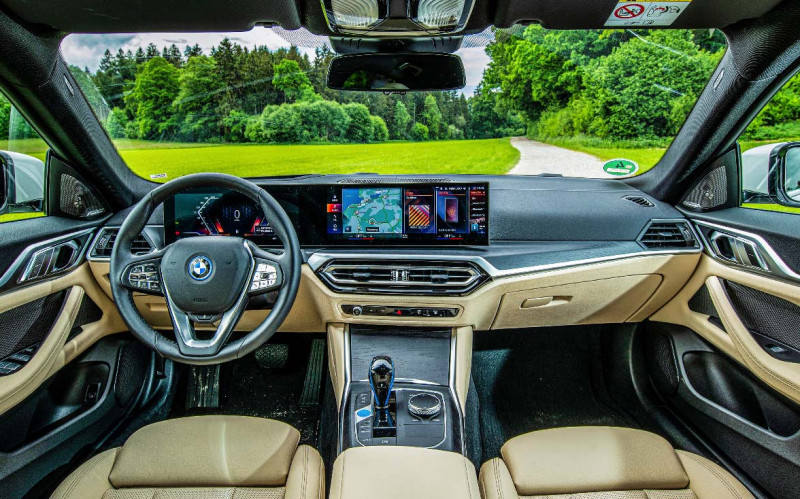
Both cars, by the way, have plenty for EV nerds to enjoy if they fancy taking a deep dive into the various graphs, curves, read-outs, projections, analyses and calculations, not to mention fundamentals like energy consumption, distance to empty and charging facilities within a given radius.
With their combustion-engined counterparts, we’ve become used to many members of the line-up having all-wheel drive, especially when you’re paying this kind of money. But entry-level powertrain means no xDrive for the BMW and no 4Matic for the Merc, just rear-wheel drive in both cases.
In many ways this is a good thing – keeping weight down and driver involvement up – but this creates traction problems in the wet when the driver tries to make use of those big, instant torque outputs. With traction and stability control in play, the occasionally sta-g-g-er-ed acceleration curve out of tight-ish bends makes it quite clear that wet-weather cornering grip can be an issue for eco-hooligans. Dismiss the electronic supervisors, and the full catalogue of power-on and lift-off oversteer will unfold.
Quite surprisingly, the Mercedes is the more playful yet better controllable car in these low-friction conditions. Its beefier torque flow is easier to modulate, its breakaway behaviour is more benign, and the 255/40 ZR20 Pirelli P Zeros are notably grippier in the rain than the aquaphobic 245 and 255/40 ZR19 Hankook Ventus S1 tyres fitted to the BMW (optional larger wheels in both cases).
Before the roads eventually dry up, the i4 can be induced to throw some extravagant shapes. Controlling these deliberately provoked slides is helped by the low centre of gravity, firm chassis set-up, gyro-friendly 50:50 weight distribution and explosive torque delivery.
Like most BMWs, this one plots its path with due accuracy, promptness and that famously unambiguous direct line to your palms, but it makes the driver work quite a bit harder at the wheel than an EQE fitted with the optional rear-wheel steering and air suspension. Rear-wheel steering not only reduces the turning circle from 12.5 metres (which is on par with the i4) to a tight 10.7 metres, it also sharpens the handling to a degree which is both entertaining and failsafe. True, the i4 is the faster car on winding roads, but the more compliant EQE does a better job waltzing to the desired rhythm and maintaining the matching flow. Fuss-free yet committed, it is the more sure-footed tool on slippery ground.
The BMW battery is good for 80.7kWh, the Mercedes equivalent is rated at 90.5kWh. While the Benz will charge its energy pack with up to 170kW, its smaller rival can cram up to 205kW into the lithium- ion cells. The WLTP official figures give a rather sunny view of how far these cars can go on a single charge: almost 400 miles for the Merc, and almost 370 for the BMW. On our test, both are pretty much done within 250 miles. Yes, they are hard miles, but there is no flat-out autobahn driving involved.
Whereas 250 miles should suffice for most two-way commutes, this restricted real-life range is not acceptable to company reps in a hurry, or to holidaymakers in countries with an underdeveloped charging infrastructure. The official efficiency figures – 3.3-3.9 miles per kWh for the EQE, 3.7-3.9 for the i4 – are similarly over-optimistic, compared to our test results: 2.3 miles for the Merc, 2.2 for the BMW. (These test numbers are very pessimistic. In the UK, back in May, we saw 2.9 miles per kWh from an i4 40, and on the EQE launch in Germany we got a similar reading.) There’s only so much that Mercedes and BMW can do about batteries and e-motors, and indeed the charging network. But they still have complete control over the design of their cars, the equipment they fit and the materials they use. And both are quite disappointing. The Mercedes cabin is impressively big, giving the rear passengers extra legroom and everyone more shoulder room. But the rear bench is oddly uncomfortable – if flattered by comparisons with the BMW’s.
While the BMW fields a larger luggage compartment (470 versus 430 litres with the rear seats in position) along with a more practical hatchback configuration, the cargo bay of the EQE must be accessed through a narrow lid with an accordingly smaller aperture. In contrast, the more upmarket EQS is equipped with a less upmarket tailgate. Go figure. Climbing into the BMW feels like coming home, as it has hung on to as much 4-series familiarity as possible. Yes, it has succumbed to in-dash digital overkill, but at least it keeps the useful iDrive controller, the surrounding switchgear and the self-explanatory shifter. Unfortunately, the trim is positively low-rent, there are no shift paddles to set the level of brake recuperation – hidden in a sub-menu – and rear legroom behind tall drivers is non-existent.
A frunk would also be nice to have, if only to accommodate the charging cable which keeps romping in the boot. The same issue plagues the Benz, the nose of which is occupied by a huge air filter.
The Airmatic suspension (standard on the top two spec levels) brings important bonus points for the EQE, but even the standard steel suspension is more compliant than the basic set-up of the i4. Since the BMW’s ambition is not only to save the planet but also to put a smile on the driver’s face, it has traded compliance for handling prowess. The EQE puts more of a focus on calm, quiet and taking the strain off the driver. Its electronic assistance is not quite up to EQS levels, but it feels like it’s quite a long way down the path to self-driving capability, although that can be sidestepped by the driver who is keen to drive.
Having tested these cars back to back for several hundred miles, I eventually stopped thinking I would get used to the brakes. The problem isn’t stopping distance – dropping the anchors yields similar energy-squashing results, which leave little to be desired – but operating these left pedals requires plenty of thought. The BMW is so grabby at low speed it’s almost embarrassing. The response is less aggressive at speed. The reverse scenario can be experienced in the Mercedes. Here, the pedal feels heavy and dead, the response is reluctant at best, the pedal pressure is too high and the modularity accordingly difficult. It’s a reminder of how fundamental brake feel is to driving pleasure – and a reminder of how much even huge hitters like BMW and Mercedes still have to learn when it comes to bringing the brilliance of their combustion cars into the electric age.
At the end of a day spent swapping between these two cars, several questions are nagging away. Why did Mercedes spend millions on a new EV matrix when the result can match but not beat the efficiency of BMW’s longer-running components set, which also supports PHEVs and combustion engines? Why is the dedicated EV platform 230kg heavier than its multi-traction counterpart? That the Benz is faster overall matters less than the 0-62mph acceleration time, which favours the BMW by 5.7 against 6.4sec. The gap widens above 70mph when the lighter i4 feels nippier and more eager to step up the pace. And why are the brakes so far from ideal on both cars, albeit in different ways?
It’s easy to dismiss this pairing as comparing apples with oranges. After all, the EQE is one size bigger and one class more expensive than the i4, which in turn is the quicker and better-handling proposal.
But there are more edges to the sword than this. In terms of pure undiluted EV-ness, it is hard not to fall for the extra space, refinement, silence, prestige and overt modernity only the Mercedes can offer. It’s an emphatically advanced automobile, airy and sophisticated, classy in concept if less so in execution.
For all its strengths, there’s no getting away from the fact that the Merc’s packaging is flawed, despite this being a car created from scratch as electric-only. And, disappointingly, the range advantage over the BMW teased by the official figures turns out in practice to be exactly zero.
Both manufacturers have many more electric products in the pipeline, not only in terms of different motor/battery combinations, but also different bodies. In the case of the EQE, the hot 53 version is almost upon us, as is the SUV variant.
Will they overcome this car’s weaknesses? We’ll see. Will they be less expensive? Definitely not. The i4 40 eDrive is more affordable, more agile if less composed, sportier overall but less comfortable. Like its opponent, it doesn’t offer quite as much excitement as you’d hope for, judged in pure driving terms. But like the roomier and more sophisticated EQE it has a remarkable level of refinement, a range that should be enough for many, and a way of making you feel good. Some things never change.
=1st MERCEDES-BENZ EQE 350+ Refined, roomy and easygoing
=1st BMW i4 40 eDRIVE More spritely than the Merc, and less expensive
Not quite right for you? Plenty more EVs coming from both very soon. Both cars avoid the temptation to go too far in their embrace of the future; buttons welcome here.
FINAL RECKONINGSO MUCH EFFORT, SO LITTLE REWARD
NEATLY EFFICIENT MEETS LUDICROUS’ Two details on the EQE highlight the challenges and opportunities facing manufacturers as their cars lose their engines and edge towards self-driving. To top up your screenwash, you simply nudge open a flap above the front left wheel, which is much easier and cleaner than opening a non-existent bonnet. That’s neat and efficient. Not so smart is the ludicrous size and position of the sensor/ scanner/camera array at the top centre of the windscreen. The irony of safety kit that stops you seeing where you’re going will stop being funny very quickly. COLIN OVERLAND
CLIMBING INTO THE i4 IS LIKE COMING HOME, AS IT HAS HUNG ON TO AS MUCH 4-SERIES FAMILIARITY AS POSSIBLE
Decent handling, but i4’s ride suffers. Merc top speed higher, if largely academic.iDrive? Check. Gearlever? Check. Gears? Not so much. The world’s insistence that blue means green remains baffling
PRE-FLIGHT BRIEFING I BMW i4
Why is it here?
Because BMW needed an answer to the Tesla Model 3 that looked less homespun than the electric 3-series derivative offered in China. This is the result: essentially a 4-series Gran Coupe with BMW’s fifth-generation EV powertrain.
Any clever stuff?
Huge boot with the rear seats folded, and that hatch rear opening makes it easy to actually use the space. Intelligent software knows what’s best for the battery and the driver’s peace of mind. Wisely, BMW has backed away from the general EV war on the physical button, instead keeping faith with the iDrive controller.
Which version is this?
The base model, the 40. For all-wheel drive and more power, go for the pricier M50 xDrive. For the M50’s looks but the 40’s powertrain, upgrade from Sport to M Sport trim.
PRE-FLIGHT BRIEFING I MERCEDES-BENZ EQE
Why is it here?
Although the bigger EQS gets the headlines, the EQE is likely to get more sales, echoing the S- and E-Class. It’s the electric extension of a tradition of Mercedes saloons going back nearly 70 years – a tradition that to a large extent defines Mercedes.
Any clever stuff?
Nothing new debuts on the EQE – the EQS grabbed all that glory. The cleverness of the EQE is taking the same EVA2 platform, scaling it down slightly, keeping most of the bigger car’s excellent aerodynamic sleekness (its Cd of 0.22 betters the i4 by 0.02) and offering impressive range despite a smaller battery than the EQS. You can spec air suspension, rear steer and a high level of driver assistance.
Which version is this?
The only one currently offered, the 350+, making 288bhp. Coming along soon (although not every market will get every version) will be the 300, 500, 43 and, first, the 53. In the UK there are four trim levels, all pretty plush – AMG Line (from £76,450), AMG Line Premium, AMG Line Premium Plus and Exclusive Luxury (closest to the spec of our German test car). In the UK, you can’t currently get the Hyperscreen; no great loss.
‘THIS REAR-DRIVE 40 FEELS MORE ALIVE THAN THE AWD 50’
The i4 40 and 50 are very different to drive. The less powerful, more affordable car is also the more nuanced, the 40 being less strait-laced and more engaging. The all-wheel-drive 50 has that EV standingstart theatre, but the rear-drive 40 feels more alive, more Ultimate Driving Machine. The cockpit lacks drama but works well enough and the BMW is both desirable and sensible. It’s quick enough, drives well, offers decent efficiency and can slip pretty seamlessly into your life (particularly if you’re able to hang onto your 530d for those non-EV-compatible trips…).
BEN MILLER
THE i4 IS THE FASTER CAR ON WINDING ROADS BUT THE EQE IS THE MORE SUREFOOTED TOOL ON SLIPPERY GROUND
Could a three-box saloon be less boxy?BMW’s boot is larger and accessed via a hatch; Merc has actual bootlid Plenty to make Merc lifers feel at home, without the EQS’s excess.
THIS IS TERRITORY THE 4-SERIES AND E-CLASS WOULD RELISH, BUT WHAT DO THE i4 AND EQE MAKE OF IT?
EQE will get frisky if you turn off the electric safety net in the wet. Time to get nostalgic for the days of fake analogue dials EQE’s screen is easy and quick to use. Also big


